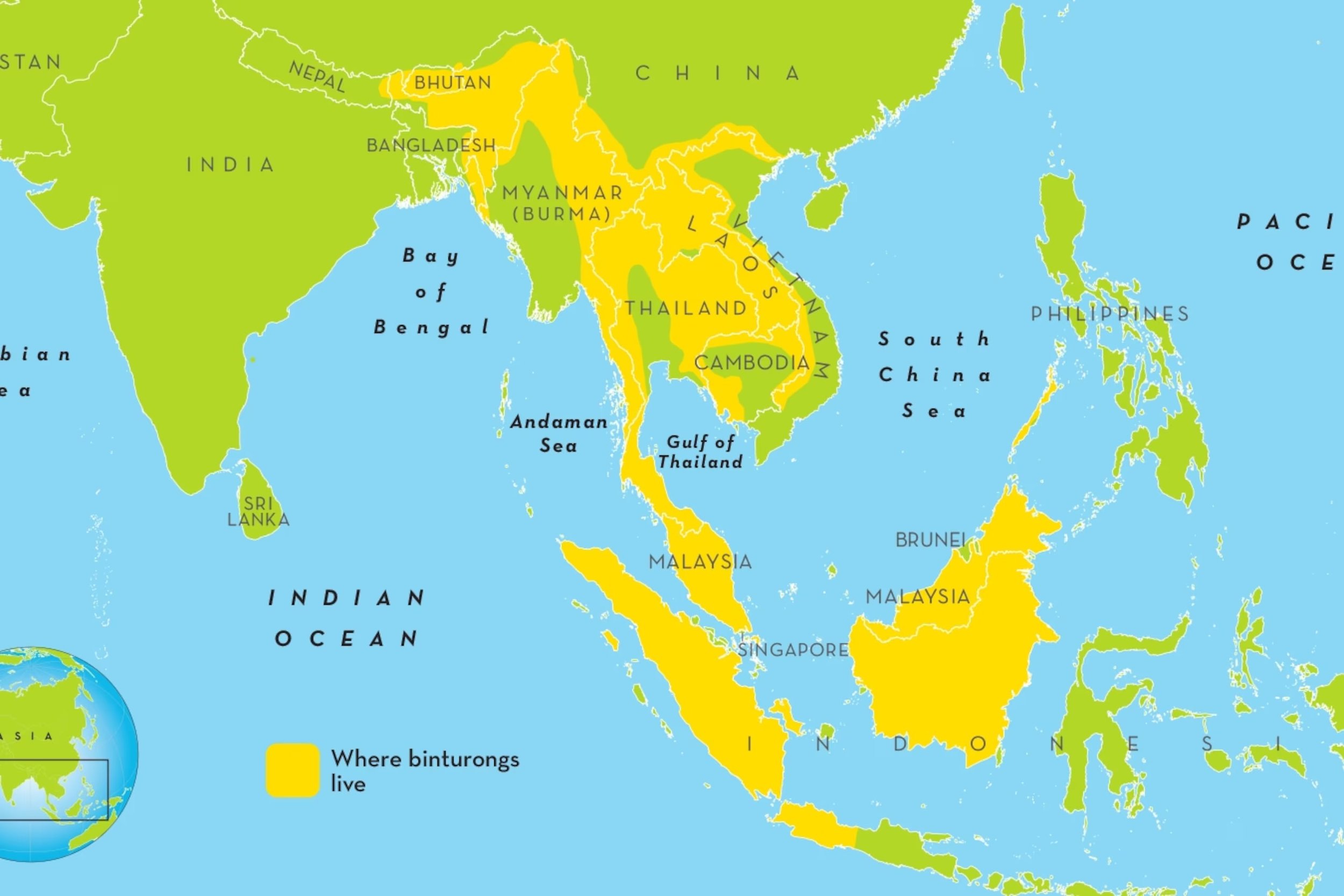It’s A Bear! It’s A Cat! It’s a...Binturong?






It’s my BIRTHDAY! So that means you get to learn about one of my absolute favorite species in the entire world! Drumroll please… (it’s already in the title, but I’m drawing this out)… THE BINTURONG!!! Or, if you’re a Taylor Swift fan who’s cyber-stalked her boyfriend, or if you’re from Cincinnati, it’s also known as the Bearcat.
What is it? Perfection, that’s what it is. Binturongs are the largest members of the Viverridae family. Viverrids are small- to medium-sized, cat-like (feliform) mammals. Binturongs are relatively big, weighing around 30-50 pounds and reaching 2-3 feet in length (not counting the tail). We’ll get to that beautiful tail later. They have shaggy fur, usually black to brown with lightening to gray or yellow tones, especially around the face. Their long, shaggy tail is very strong and critical to their arboreal (tree-dwelling) lifestyle. More on their tail superpowers later.
Where can you find them? Binturongs can be found in the tropical forests of Southeast Asia (see map below for their range). Binturongs are arboreal and spend most of their lives in the trees. Since they’re rather stocky, they’re not as agile as monkeys and don’t jump from branch to branch. Instead, they climb down one tree and amble over to the next.
What do they eat? Although they’re technically carnivores, they mostly eat a variety of fruits, with the occasional mouse here and there. Binturongs play a key role in jungle health by eating many fruits and spreading the seeds in convenient, pre-fertilized packages (yes, they poop the seeds out!). They’re one of the few animals that can eat the fruit of the strangler fig, a key jungle-building tree. The binturong I used to care for, Timber, loved grapes and bananas. She was so clever she would peel her bananas—girl had standards!
What does Binti romance look like? They’re all about communication. Binturongs use scent glands to convey a variety of messages, like when it’s time for making “binlets” (which is just the cutest). Males will seek out females in heat, and if they manage to woo her, they’ll spend time together. Sometimes the male stays for a day or two, but some males have even stayed with the female until after birth. A cool fact about binturongs: they can delay pregnancy until conditions are favorable, a phenomenon called embryonic diapause. Once truly pregnant, the female carries her young for about 90 days and often gives birth to twins.
Do Binturongs have superpowers? Oh, they do! First, there’s that glorious tail. Their tails are prehensile, meaning they can use them as an extra appendage. This tail is incredibly handy for climbing or taking a snooze in the branches, as they use it to wrap around a branch and secure themselves. Binturongs are one of only two carnivores with prehensile tails (the kinkajou is the other). Now, here’s everyone’s favorite fun fact: binturongs naturally smell like movie theater buttered popcorn! It makes going to the movies a bit confusing for me. There’s some debate about whether they smell more like popcorn or Fritos, but I am 100% Team Popcorn. Another superpower? Their ankles can rotate 180 degrees, allowing them to maintain a firm grasp on the tree, even when climbing down head-first. And lastly (I have to limit myself!), they have an impressive range of communication skills. They use scent, body language, and a wide array of vocalizations. I can tell you firsthand—a binturong will let you know exactly how they feel about you or the situation.
How many Bintis are there? While there can only be one Binturong, they do have two major sub-groups, or clades: the Northern Clade and the Sundaic Clade. Within these clades, there are nine sub-species.
This my friend Jake and Wilbur, who is an excellent ambassador for his species. Love them both.
Science Time!
There are 9 subspecies of Binturongs. I looked everywhere, but could only find seven. I will endeavor to find the missing two. Since they are all the same species all the scientific names are Arctictis binturong. I will show their third subspecies name.
Palawan binturong - A.b. whiteii
Cambodian binturong - A.b. albifrons
Malayan binturong - A.b. binturong
Bornean binturong - A.b. pageli
Javan binturong - A.b. penicillatus
East-Sumatran binturong - A.b. kerkhoveni
Chinese binturong - A.b. menglaensis
According to the IUCN Red List, binturongs are listed as Vulnerable. Their numbers are going down. They face threats from habitat loss and fragmentation, agricultural, being hunted for meat, and trapped. There are groups that help binturongs, but really their whole ecosystem needs preserving. Please check out the link that will direct you to the Cheyenne Mountain Zoo’s Palm Oil page and their super helpful app you can download for free.
Resources:
ABConservation. (n.d.). The Binturong. https://www.abconservation.org/en
San Diego Zoo. (n.d.). Binturong. Animals and Plants. https://animals.sandiegozoo.org/animals/binturong
Willcox, D.H.A., Chutipong, W., Gray, T.N.E., Cheyne, S., Semiadi, G., Rahman, H., Coudrat, C.N.Z., Jennings, A., Ghimirey, Y., Ross, J., Fredriksson, G. & Tilker, A. 2016. Arctictis binturong. The IUCN Red List of Threatened Species 2016: e.T41690A45217088. https://dx.doi.org/10.2305/IUCN.UK.2016-1.RLTS.T41690A45217088.en.



